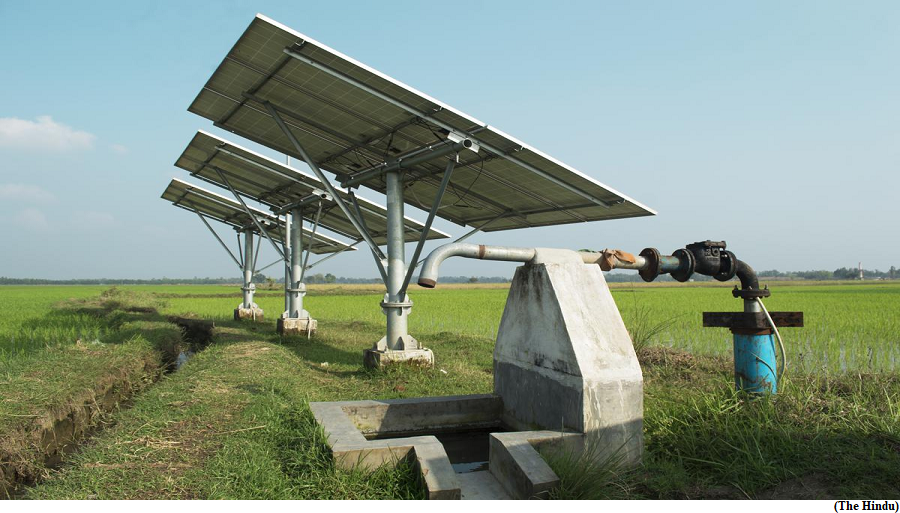Cleantech, for an inclusive green future in India (GS Paper 3, Economy)

Context:
- In his address to the nation on Independence Day 2023, Prime Minister talked about India showing the world how to combat climate change.
- India’s experience has shown that climate action is only effective and embraced at scale if it aligns with the development aspirations of millions and contributes to economic growth.
- By focusing on cleantech solutions to bolster livelihoods, especially in rural areas, India can achieve an inclusive green transformation.
What is cleantech?
- Clean technology is also referred to as cleantech, green technology, and greentech.
- It defines a set of technologies that either reduce or optimize the use of natural resources, whilst simultaneously reducing the negative effect that technology has on the planet and its ecosystems.
- Examples of such technologies are relatively new sustainable energy sources, such as wind and wave power, or improved conventional energy production processes, such as smart electric grids.
Green economy paradigm:
- The green economy paradigm provides an optimistic pathway to align development and environmental outcomes.
- For instance, building a solar park or an electric vehicle charging station helps expand the much-needed infrastructure in a developing economy while furthering climate action.
- Similarly, reviving millets helps improve farm incomes in rain-fed areas while making our agriculture climate resilient.
Initiatives in the hinterlands:
- In recent years, different initiatives have taken the green economy approach to the hinterlands of India by enabling access to cleantech solutions for livelihoods among the rural population.
- Some of the 50,000-plus examples of how cleantech solutions are already contributing to the jobs and incomes of rural women and men include
- solar dryers converting throwaway tomatoes into sun-dried ones in Andhra Pradesh,
- biomass-powered cold storages helping farmers in Maharashtra selling lemons make a gain that is three to five times that of the original price, or
- solar silk reeling machines reducing drudgery for thigh-reelers and doubling their income in Odisha
Structural boost:
- India’s rural economy that comprises 120 million farmers and 34 million microenterprises often struggles with unreliable electricity access and a dependence on expensive and imported diesel.
- These cleantech solutions that are powered by renewable energy can help India reduce its diesel imports, avoid the loss of perishable food and enhance rural livelihood opportunities while posing an investment opportunity worth $50 billion for investors and financiers.
- Research at the Council on Energy, Environment and Water (CEEW) shows that just 12 such cleantech solutions (varying from solar pumps to cold storages to charkhas and looms) have the potential to impact at least 37 million livelihoods or about 16% of our rural population.
- There needs to be a three-fold approach to traverse this journey from 50,000-plus to tens of millions.
Steps to scale up cleantech solutions:
Leverage existing government programmes supporting livelihoods:
- For instance, the Pradhan Mantri MUDRA Yojana that extends collateral-free loans for microenterprises can be used to enable the adoption of cleantech solutions.
- Similarly, the Pradhan Mantri Formalisation of Micro food processing Enterprises (PM-FME) scheme that supports the adoption of technology among micro food enterprises can be used to unlock support for solutions such as a solar dryer, an energy-efficient multipurpose food processor or a solar grain mill.
- Likewise, the Pradhan Mantri Matsya Sampada Yojana can be leveraged towards adopting solar refrigerators and dryers for fishing communities.
- Finally, the Agriculture Infrastructure Fund, which has only seen a 15% fund utilisation against a target of ₹1,00,000 crore, can support the adoption of biomass-powered cold storage and beyond.
Enable large-scale financing of cleantech solutions:
- It requires supporting bankers’ capacity on credit assessment for cleantech because they have not come across such solutions and the associated cash flows before to make an informed assessment.
- There is also need to hedge their risks in the initial stages of the market through partial guarantees. Moreover, active engagement with financiers is important to structure loan products that are aligned with the cash flow scenarios of users.
- Adopting some of these principles helped ‘Powering Livelihoods’, a CEEW-Villgro initiative, unlock 300-plus loans for cleantech solutions to women, self help groups, farmer producer organisations and individual microentrepreneurs in rural areas.
Multi-actor partnerships:
- Enable multi-actor partnerships between technology innovators, manufacturers, distributors and service providers, financiers, and market-linkage players to enable an overall ecosystem. Cleantech manufacturers often need help bringing their products to customers.
- The challenges faced include low product awareness, high customer acquisition cost as users need to touch and feel these products before adoption, and low density of customers for such products in a given area.
- Users too, at times, struggle with limited after-sales service and market linkage of the final processed products.
Way Forward:
- There is need for a holistic ecosystem where distributors work with manufacturers to enable technology access at the last mile, service providers ensure after-sales services, and market-linkage players enable the connection to the market to create a thriving ecosystem for cleantech to impact rural livelihoods at scale.
- For instance, there are solar dyer companies that are not only deploying dryers but are also enabling financing for users to adopt the dryers and buying back the final produce from them to ensure market linkages.
- India has massive ambitions for a clean and green future. By focusing on cleantech for livelihoods and jobs, especially in rural areas, green future can be made inclusive.


